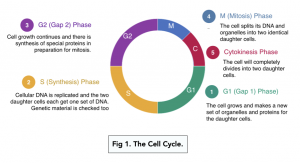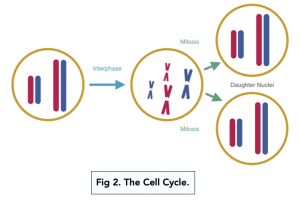Cell Division: The Cell Cycle (A-level Biology)
Cell Division: The Cell Cycle
Overview of the Cell Cycle
The cell cycle refers to the regulated sequence of events that occur during cell division, as one parent cell divides to form two genetically identical daughter cells.
The cell cycle can be broken down into 3 phases:
- Interphase
- S phase – DNA replication
- Growth phase (G1 + G2) – new proteins and organelles are made
- Mitosis – the nucleus divides and chromatids separate
- Cytokinesis – the cytoplasm divides

Interphase
G1, S, G2 Phases
- There are 3 phases of interphase. These are G1, S and G2. Each phase has unique events that occur.
- G1 phase. G1 stands for Gap 1 phase. In this phase, the cell grows and makes a new set of organelles and proteins for the daughter cells.
- S phase. S stands for Synthesis phase. In this phase, the DNA in the cell is replicated, so that the two daughter cells can each get one set of DNA. There is also checking of genetic material in this phase.
- G2 phase. G2 stands for Gap 2 phase. In this phase, cell growth continues and there is synthesis of special proteins in preparation for mitosis.
Interphase → Mitosis
- During interphase, cell function continues normally. In addition to preparing itself for cell division, the cell continues to carry out normal functions that it is responsible for.
-
- Hepatocytes in the liver, for example, continue to carry out their normal responsibilities involving detoxification.
- Epithelial cells that make up the villi in the small intestine continue to absorb nutrients from digested food and transport them into the blood.
-
- The cell cycle ends with mitosis. During mitosis, also known as the M phase, the cell splits its DNA and cellular components (i.e., organelles) into two identical daughter cells.

Mitosis
- After interphase, the cell divides in mitosis. The eukaryotic cell divides to produce two daughter cells, each with the identical copies of DNA produced by the parent cell during DNA replication
- There are two main types of cell division.
- Mitosis is the mechanism of cell division that occurs in cells called somatic cells. Somatic cells are the majority of dividing cells in an organism.
- Meiosis is a cell division process that occurs only in cells known as gametes. Gametes are the sperm and the egg, which play a role in sexual reproduction.
In the next tutorial, we will focus our attention only on mitosis. But do pay close attention as much of the processes in mitosis show up in meiosis as well.
The Need for Cell Division
- Cell division has multiple functions. Cell division is essential for ensuring the survival of the organism for its given lifespan. In particular, mitosis is necessary for:
- Growth. Multicellular organisms grow in size by increasing the number of cells in their bodies through mitosis.
- Replacement of dead cells. Dying cells are replaced by identical cells produced through mitosis.
- Repair of tissues by cell replacement. In eukaryotes, most structures which have become damaged can be replaced by new daughter cells.
- Asexual reproduction. Some organisms (e.g. wasps, strawberry plants, and yeasts) reproduce asexually through mitosis (i.e. does not require the fusion of gametes). The resulting offspring will be genetically identical to its parents.
- Some cells cannot divide. In most eukaryotic organisms, there are two types of cells. Cells that can divide and cells that cannot divide (e.g. neurones).
The cell cycle is the sequence of events that a cell goes through as it grows and divides into two daughter cells. It consists of two main stages: interphase and the mitotic phase.
Interphase is the first stage of the cell cycle, during which the cell grows and replicates its DNA in preparation for division. This stage is further divided into three sub-stages: G1, S, and G2.
During the G1 phase, the cell grows and performs normal functions. During the S phase, the cell replicates its DNA. During the G2 phase, the cell checks for DNA damage and prepares for the mitotic phase.
The mitotic phase is the second stage of the cell cycle, during which the cell physically divides into two daughter cells through a process called mitosis.
Mitosis is a series of steps that involve the duplication and separation of the chromosomes, as well as the division of the cytoplasm. This ensures that each daughter cell receives a complete set of chromosomes and the necessary components to function as a separate cell.
The regulation of the cell cycle is important because it ensures that cells divide at the right time and in the right way. Any errors in the cell cycle can lead to problems such as uncontrolled cell growth, which can result in cancer.
The cell cycle is regulated by a series of checkpoints, which monitor the progress of the cell cycle and ensure that the right events happen at the right time. If any errors are detected, the cell cycle is stopped until the problem is corrected.
The cell cycle is closely linked to cancer, as uncontrolled cell growth and division are key features of many types of cancer. Understanding the regulation of the cell cycle is important for the development of treatments for cancer.






Still got a question? Leave a comment
Leave a comment